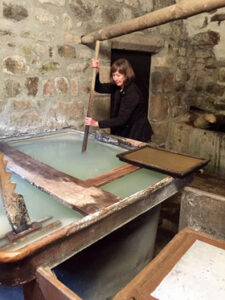This post was written by NCTE member Joyce Kinkead.
Add Slow Writing to the list of “slow” choices—slow food, slow travel, slow fashion—in the lifestyle movement that asks people to consider their lives less as a stressful rat race and more as living in mindful ways. Slow Food focuses on sustainable, local, and organic products for nourishment; its symbol is the snail. Likewise, Slow Writing feeds the brain by engaging in writing that chooses pen, ink, and paper for its aesthetic and tactile properties.
Those who savor the act of writing include self-professed pen nerds who value fountain pens with ink that flows smoothly and nibs that glide over the page. New York magazine ranks writing implements in “100 Best Pens.” The Laban Pen Company’s motto plays into the healing power of writing with its motto “Refill your soul by writing.” The lowly pencil gets the same treatment by some writers. Caroline Weaver, author of The Pencil Perfect (2017) and Pencils You Should Know (2020) calls herself a “life-long pencil obsessive.” Using high-quality writing implements counteracts the disposable pen. Americans discard 1.6 billion pens annually.

Even if Hemingway didn’t truly use a Moleskine notebook, it has become legendary. Cydney Alexis found in a research study, “The Symbolic Life of the Moleskine Notebook: Material Goods as Tableau for Writing Identity Performance,” that writers build their own identity through the objects they choose for composing. A Moleskine notebook, paired with a Lamy fountain pen, may actually enhance the writing experience.
The Moleskine is a popular choice for those who have adopted Bullet Journals (BuJo®) in which writers “reflect on the past, organize the present, and imagine the future” in mindful ways. Also called “dot grid” journals, the system was developed and popularized by Ryder Carroll as an aid to living more intentionally and productively. It can include tasks, lists of movies to see, dreams, and goals. While the writer doesn’t have to be an artist, BuJos are often highly illustrated with drawings or calligraphy.

Handmade paper emerges in fine stationery and greeting cards as it carries with it centuries-old traditions. After the devastating earthquake in Nepal, its artisan paper sales around the globe contributed to reconstruction. In fact, slow writing takes into account ethical choices. Poo-poo paper made from elephant dung at Thai sanctuaries provides an alternative economy and also contributes to saving the enormous pachyderms.
Digital writing may be so 20th century. Handwriting is in. Even if cursive is absent from the curriculum, children and adults may improve their pen work through self-help guides and workshops. And for good reason. A manual on letter writing advises, “A handwritten note is like dining by candlelight instead of flicking on the lights.” These are potential keepsakes that signal the writer has invested time and thought in penning the words. Research has also demonstrated that handwritten thank-you notes have “win-win benefits” for writer and recipient. In fact, handwritten notes enjoy such status they have spawned an industry to produce printed notes and cards that look like they’ve been handwritten
The turn to a slow lifestyle is a reaction to materialism, industrialization, and consumerism. As teachers and students embrace a more mindful and reflective way of being in classrooms, slow writing can be a path for English and language arts to explore in their curriculum. Although one-on-one laptop programs have been adopted in many schools, research has shown that hand-to-brain learning is more effective when students take notes by writing rather than typing.
My own recognition of Slow Writing came through research on a book project focusing on the history of writing, starting with its origins some 5000 years ago. While I celebrate the increased efficiency of computers—I’m one who remembers and used Liquid Paper—learning about the evolution of implements for writing was instructive: reeds, metal stylus, quill pens, pencils, fountain pens, ballpoint pens, and felt tip pens.
Developed during World War II by the Bíró Brothers who escaped Europe for Argentina, the ballpoint pen, for instance, revolutionized writing, particularly for the pilots of the Royal Air Force who popularized the pen by buying 30,000. I found when I queried my students about their favorite writing implements, many had strong feelings about preferred pens and pencils. Some of them also specified the type of paper or notebooks they prefer. The material culture of writing is important.
I am not a Luddite. I’ll be keeping my digital tools, thank you very much, but times exist when it’s helpful to change the pace and engage in slow writing, the kind of writing that speaks volumes to the recipients and makes us more connected. When it’s appropriate, consider the letter or card on handmade paper, even to the point of adding thematically appropriate postage, decisions that signal that every aspect of this missive was chosen with its recipient in mind.
Email, it rushes to and fro
Since paper letters seem too slow
But we prefer the status quo
This card was sent by escargot.

Joyce Kinkead is Distinguished Professor of English at Utah State University, where she teaches courses in Writing Studies, including research methods and the history of writing. Her current book project is called A Writing Studies Primer and draws on an around-the-world trip that took her to dozens of sites in the history of writing and its material culture. Reach her on email: Joyce.Kinkead@usu.edu. Twitter: @JoyceKinkead
It is the policy of NCTE in all publications, including the Literacy & NCTE blog, to provide a forum for the open discussion of ideas concerning the content and the teaching of English and the language arts. Publicity accorded to any particular point of view does not imply endorsement by the Executive Committee, the Board of Directors, the staff, or the membership at large, except in announcements of policy, where such endorsement is clearly specified.

